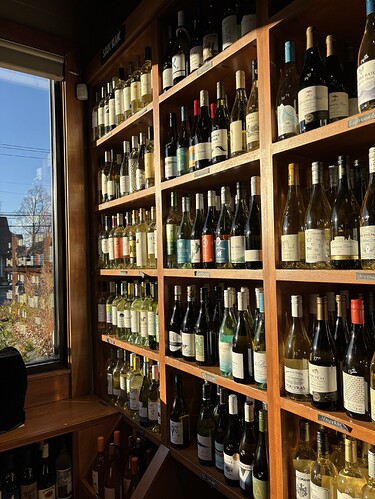Eurocave chat mentioned to me the Pure version glass is lightly tinted and as UV protection
Ha! Knock on wood, I’ve never experienced anything that i would consider ‘light strike’ on any of my bottles that I’ve opened. Of course there’s always the possibility that i just didnt notice/realize it had happened…but it for sure has not been an issue for me ![]()
No but I had a root day once.
All of the best beers I’ve had were from keg. That includes beers where I’ve had an enjoyed the bottled version. In wine ratings terms, with great beers the difference is about 6 points, when it’s 92 or 93 from bottle. Good versus stunning.
From a brewer’s perspective, there is no difference between a keg and a can, at least at the brewery. It all comes from the same tank, and at least at our brewery, it all goes in the same cold room. Once the beer leaves us, we have no control over what happens to it. It could be that the kegs get treated better than the cans we sell, but a 6 point difference? I don’t think so, unless you need a better beer store.
Makes sense. A lot of breweries claim cans are superior to bottles, and a lot of beer geeks claim canned versions are better than bottled versions of the same beers. When i brew, i bottle ferment. The only light is during primary and settling. After bottling they sit in boxes. Sometimes a lot longer than recommended, but drinking well.
I was talking about good bottles of beer, not cans. I’ve bought Weihenstephaner Vitus multiple places, where it’s been consistently good, as in 93 points good. Having it from a direct imported keg at Gourmethaus Stadt in Redwood City, CA it was just flooring how good it was. Of course they’re beer nerds in the extreme, paying attention to every little detail of service, including glass type.
Any time you’re talking about imported beer, you’re bringing in all sorts of additional issues. So much of what gets imported is totally abused, and the odds of abuse are much higher in bottles/cans than in kegs.
The good citizens of CAMRA in the UK would vehemently disagree. For many decades they’ve fought for cask conditioned ales, over kegs. Indeed what’s known as craft beer, last time I checked, is still excluded from their guides and awards.
For them it’s the equivalent of traditional nebbiolo vs. the modernist variant, but without the genteel subtlety of wine drinkers in matters of disagreement.
I certainly remember an era when the reverse was the case, and a premium was (happily) paid for bottles. The canned product used to be universally and very noticeably inferior. That’s changed in the modern era, but it took me a while to wrap my head around it.
I love a nice cask conditioned bitter or porter. But I was in London just a couple of years ago, and struggled to find a bar serving from casks, and couldn’t find a single porter on tap at all. In fact, it seemed most of the locals were drinking some kind of Italian pilsner from bottles. A real head scratcher.
#Londoners ![]()
![]()
![]()
Porter very much a long time favourite of mine, along with similarly dark xmas/winter ales (and mild, that very Black Country thing, perhaps a factor of where I grew up).
I had a really fun beer a few years ago, one of the one-off Tap X series by Schneiderweisse… a wheat beer porter, which leveraged two of my strongest favourites in beer, Porter and wheat/weiss beers. Not cheap, but compared to wine, a bargain for the interest and joy. It sounds like it shouldn’t work, but for me it was stunningly good.
Yes, Ian. Back in the day, canned beer tasted like a can. It took me till very recently to undo the mindset that can= inferior beer.
I also prefer draft over all other options. Probably also a throwback to the times and skunked bottles
Back in the day, canned beer tasted like a can.
Or worse. We were given a Coors Light taste test at a party a decade ago. First you lick the can. Then, after a moment to ponder, you take a taste of the contents. The can has that aluminum taste. With the beer, add in carbon dioxide and a sort of stale urinal cake element. Its not better.
I love a nice cask conditioned bitter or porter. But I was in London just a couple of years ago, and struggled to find a bar serving from casks, and couldn’t find a single porter on tap at all. In fact, it seemed most of the locals were drinking some kind of Italian pilsner from bottles. A real head scratcher.
This is confusing to me. I grew up in London and go back regularly. Never an issue finding cask-conditioned real ale. It’s true that it’s not in every pub like it used to be, but not a rarity. True that porters aren’t that popular but that’s been true for a long time.
I’m guessing you know your way around better than me.
I was there one night and stumbled into 3-4 bars including one that was supposedly one of the oldest, and struck out at every one. I just kind of assumed I could go just about anywhere and find bitters and porters on cask.
And I swear most of the locals were drinking Italian pilsners from bottles.
Not Porter and the place has changed in ways the former publican wouldn’t recognize, but I’ve been drinking Guinness at The Toucan Bar in Soho regularly since 1975.
Look in the Good Pub Guide or CAMRA’s site for the best pubs. I bet there are apps too.
Agreed, the good beer guide presumably still on public sale in bookshops. Whilst CAMRA could sometimes get into stupid **internal spats, I always found the guide very good at identifying pubs that cared about the beers, and indeed environments conducive to drinking them.
** true of rather too many British member organisations.
I was reminded of this post when I visited a local wine shop this afternoon. All the white wines in clear or light colored bottles were placed right by the window getting directly blasted by the sun. Might be interesting to get one of these and compare it with the same bottle from another retailer without the same sun exposure.

